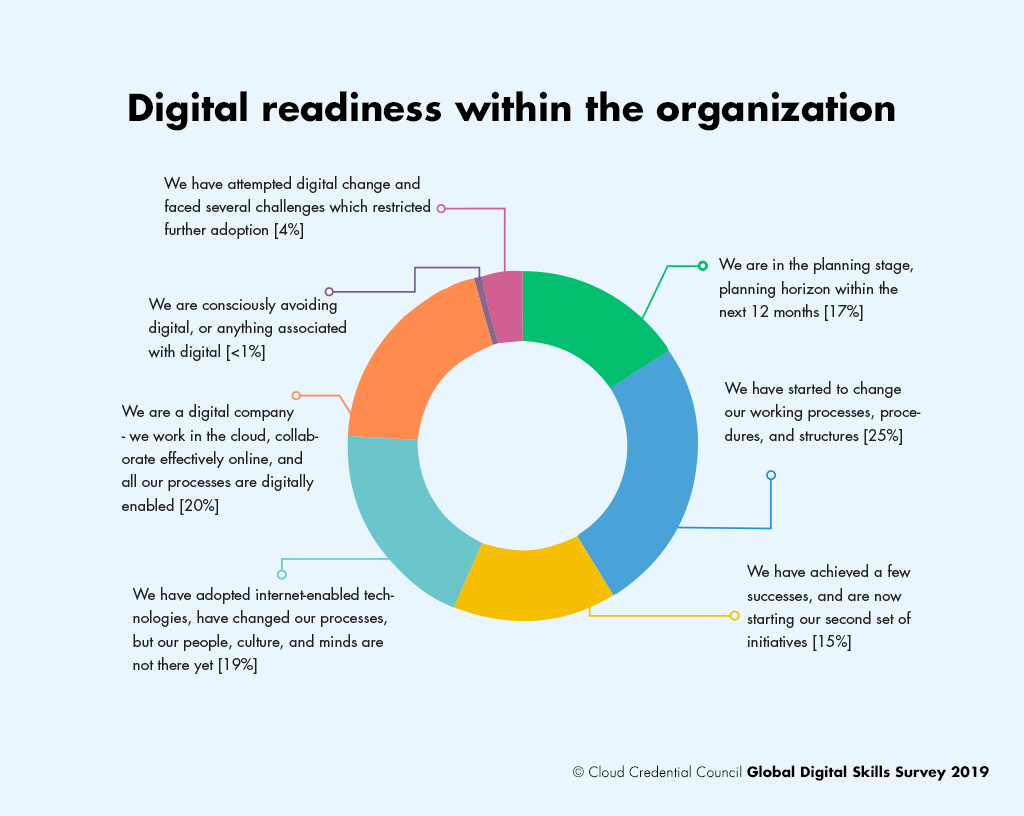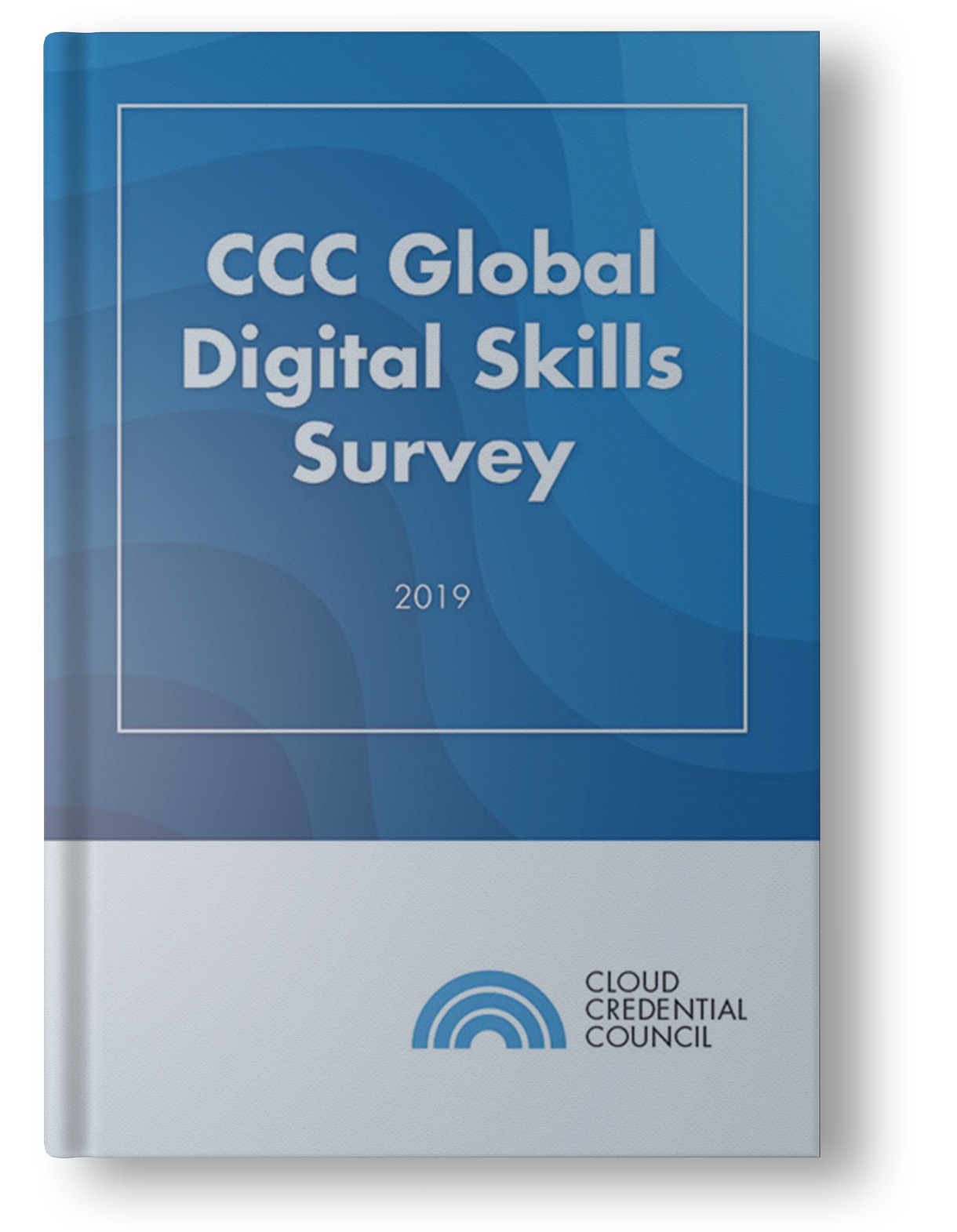Digital Readiness in the Organization

Mark O'Loughlin

Our Global Digital Skills Survey 2019 report identifies three critical and eight key findings. The analysis covers cultural, individual, and organizational readiness for the changes which are being brought about through the impact of digital.
In this blog, I am focusing on the following critical finding:
Digital Readiness in the Organisation
The global trend continues. Organizations around the globe continue to adopt more and more cloud and digital IT services. In a recent report, Gartner forecasts worldwide public cloud revenue to grow by 17.5% in 2019. There are also many reports indicating strong growth in other Digital IT services including cloud, IoT, Big Data, Blockchain and Artificial Intelligence (AI). See some of the Top 10 Digital Transformation Trends for 2020.
Our research indicates that organizations are defining strategies for the adoption of cloud and digital technologies. What is less clear is how effective these strategies will be in delivering expected, and required business results. It is not enough to just use the cloud or to start using blockchain for the sake of it. There must be clear reasons for adoption, and these reasons should be understood from a business perspective e.g. increasing competitive advantage, improving organizational agility, providing customers with new products and services, etc.
Organizations need to examine and understand the readiness of their people, staff, workforce, management, and leaders, etc. This includes an examination of the culture within both the IT function and throughout the organization itself.
There is no point in having highly scalable, agile and elastic IT and business services if the IT function and the organization itself are not agile and is tethered to bureaucratic and siloed processes and ways of working. What is gained in technical agility is lost in organizational bureaucracy.
Our analysis also highlights a gap whereby organizations have not considered, developed, nor adopted strategies to address how to bring about changes in their culture including attitude and behavioral changes from their staff. As can be seen from the graph, digital readiness is at varying and different levels which is not surprising.

What we can say with confidence is that adopting technology alone will not lead to a direct change in attitudes, behaviors, and culture on its own. So, are organizations focused too much on technology change? Worse still, is the focus on technology change for the sake of technology change?
What is surprising is the low percentage of organizations reporting challenges when asked about the digital readiness within their organization, coming in at 4%. On further analysis, we believe this result can be explained as organizations taking one of these two approaches:
- Guarded Approach. Organizations who knew to expect challenges in adopting new cloud and digital technologies. However, they may not have known the full extent of those challenges. Therefore, a more cautious approach is likely to have been taken.
- Pioneering Endeavour. Organizations that prefer, or need, to adopt new cloud and digital technologies first, identifying the challenges as they progress. During this journey, the organizations adapt to meet and overcome these challenges.
The mantra surely is that Digital is the way forward with under 1% of respondents citing that they are consciously avoiding digital. So as expected, digital technologies are a market trend where adoption is rising, with good use cases are emerging.
The question is; how ready are the organization, IT professionals, and the staff? How ready and enabled are the people, business processes and ways of working in being able to adopt these new digital technologies and adapt their ways of working to fit.
What is evident from the Global Digital Skills Survey 2019 is that organizations now require their staff to be able to adapt to these new technologies and the new as-a-service models which they are delivered under. In effect, organizations now require their staff to have the ability to acquire new skills quickly, as opposed to having specific skills. This is going to be easy for some in the workplace and very hard for others. This finding itself represents a significant change in what organizations valued or sought from the labor market.
There are many changes happening in today’s organizations and in the workforce requirements of many businesses, digital native or not. This is just one of those changes but is a significant change. Recognize the changing landscape in your organization, in your market sector, in your professional work life.
Focusing on technology alone will not deliver digital success, digital innovation, or digital value — it will only deliver new technology, not business results. Upskill your organization with the appropriate range of digital skills which are business and technology-focused.

The CCC Global Digital Skills Survey 2019 Report
The report identifies three critical and eight key findings. The analysis covers cultural, individual, and organizational readiness for the changes which are being brought about through the impact of digital.

About the Author
Mark O'Loughlin is the Managing Director of the CCC. Mark is internationally recognized as a global thought leader and published author in digital IT, cloud computing, DevOps, cloud service management, and IT Service Management.
Never miss an interesting article
Get our latest news, tutorials, guides, tips & deals delivered to your inbox.
Keep learning



